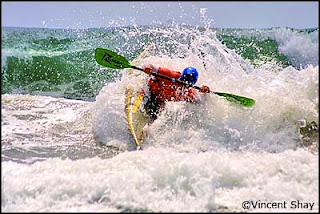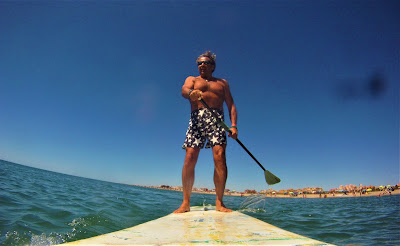Surf Zone Qicktips
En el discoduro tenía esta lista de reglas a tener en cuenta en la Zona de Surf -la Zona de Olas rompientes- ; No recuerdo la fuente -una página de kayak de mar, sin lo citaria-, pero guardé la lista porque es francamente buena; -además exportable en su mayoria a cualquier otra actividad, o transición (ek. en windsurf o submarinismo) por la zona de olas ; Está en ingles, pero se entiende bien (os la traduciré en agosto) . Cubre los tres ejes del tripode de riesgos de RBC Riesgo Bajo Control. (Equipo, Ambiente y Persona), incluye riesgos genericos (hipotermoa, deshidratación..); recomendaria leerla en coordinación con "reflexiones desed mi bañera" -para ponerla en contacto con riesgos reales.

Deck lines are great especially when you need to grab your kayak when swimming in the surf zone.

"It is easier to cool off than to warm up.
Deck lines are great especially when you need to grab your kayak when swimming in the surf zone.
As they say in Hawaii, Never turn your back on the ocean.
Paddle with purpose in the surf zone.
If you want to feel stable use supportive strokes in the surf zone.
If the waves are to big don’t be afraid to look for another launching or landing spot.
If you want to keep your gear when going through the surf zone make sure it is secure.
Make sure you time your launchings and landing so you are NOT where the wave breaks on you.
Loose hips will not sink ships. If you want to stay upright relax and let the kayak react.
Remember, you edge your kayak and lean your body.
Keep those elbows pointing down on a high brace.
Take that forward stroke so you are spearing the oncoming wave of water.
It is your responsibility not to run over others in the surf zone.
Watching the horizon and paddling around the group will reduce the chance of motion sickness while waiting in the staging area.
Remember to lift rudders and skegs before landing your kayak.
When you are out of your kayak, stay on the upstream side, so it doesn’t run over you after a wave hits it.


If there is no chance of avoiding an obstacle, it is better to hit it with the bottom of your kayak.
Always listen to the latest forecast from your marine radio before you go onto the water.
If you want more options in the surf zone, learn how to roll.
Take care of your equipment and it will take better care of you.
In order to get good, you need to practice, practice, practice.
One of the quickest ways to get close to a kayaker within a paddle length distance is to have them grab your paddle and then pull towards one another. It is a lot faster than doing a draw stroke.
If you have to get to the other side of your partners kayak try "walking the kayak" instead of paddling around to the other side.
In a multiple capsize situation it is quicker for each paddler to do a solo recovery instead of swimming their kayaks to each other and doing the traditional "all in recovery." Whoever finishes their solo recovery first can then help the others who are in progress of saving themselves. Of course this is dependent upon proper recovery equipment and the ability to do solo recoveries.
Lift the bow instead of the stern for a quick drain of the cockpit. Assuming there is a rear bulkhead
The quicker you flip a kayak upright the less water it will scoop on the way up.
Take the time on shore to check your partner's equipment, hatch covers, bulkheads and recovery equipment. It will definitely save time later.
Deck lines are a definite time reducer. If you don't have them install your own.
1/8" or smaller decklines are hard on your hands, and can give you a nasty rope burn, since they're so hard to grip.
1/8" or smaller decklines are hard on your hands, and can give you a nasty rope burn, since they're so hard to grip.
If you use deck rigging to do a paddle float recovery then customize the ri gging to make it go faster.
gging to make it go faster.
 gging to make it go faster.
gging to make it go faster.Vinyl drybags are more durable than nylon, but are difficult to stuff into a crowded compartment, and get too stiff to open in really cold weather.
If your legs or feet get numb or "go to sleep" while you're paddling, add some minicell foam under your thighs (think of making your seat longer) to spread your weight over a larger area.
If your legs or feet get numb or "go to sleep" while you're paddling, add some minicell foam under your thighs (think of making your seat longer) to spread your weight over a larger area.
If you're on a trip, partially inflating your paddlefloat under your thighs will do the trick. Either solution is better than doing the "drunken paddler falling up the beach" impression upon landing.
Don't trust deck bungees to hold anything important. Chart cases should be physically tied to the bungee, rather than simply tucked underneath.
Use a water bladder rather than a water bottle. Rig it so you can drink while paddling. Your body is a more efficient machine when fully hydrated, and you'll paddle faster and cover more distance in a day.Camel Backs and other water pouches can be carried on your back or attach to some PFD's.
Carry your flares and signaling gear in your PFD pockets rather than in your kayak. If you lose contact with your kayak, you'll want the gear on your person. My bag is too big for my PFD so I train myself to never lose contact with my kayak.
Don't trust deck bungees to hold anything important. Chart cases should be physically tied to the bungee, rather than simply tucked underneath.
Use a water bladder rather than a water bottle. Rig it so you can drink while paddling. Your body is a more efficient machine when fully hydrated, and you'll paddle faster and cover more distance in a day.Camel Backs and other water pouches can be carried on your back or attach to some PFD's.
Carry your flares and signaling gear in your PFD pockets rather than in your kayak. If you lose contact with your kayak, you'll want the gear on your person. My bag is too big for my PFD so I train myself to never lose contact with my kayak.
You can never have "too much" torso rotation.
A cheap waterproof camera is more valuable than an expensive SLR camera that takes quality pictures, since the waterproof cheapie can be more accessible and you'll be more likely to use it. Take close-ups and candid shots of your paddling buddies, they'll turn out better than your scenery shots, and you'll enjoy them more after the trip is over.
Relief zippers in drysuits and wetsuits are a Good Thing Dress for the water temperature and if you get too Hot, roll"
Espero que os sean de utilidad; Nos vemos en el agua



Comentarios